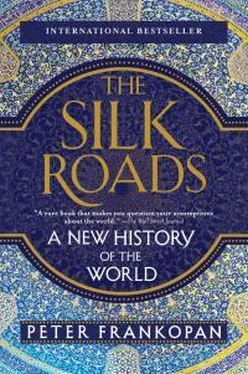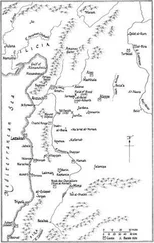Adherents of Zoroastrianism positioned themselves close to the centre of power when the Sasanians took the throne and did much to concentrate administrative control in their hands at the expense of all other religious minorities.32 This was now projected into the new regions controlled by the Persian rulers. Inscriptions commissioned by the chief priest, Kirdīr, in the middle of the third century AD celebrated the expansion of Zoroastrianism. The religion and its priests had come to be esteemed and honoured far and wide, while “many fires and priestly colleges” had flourished in lands that had been conquered from the Romans. A great deal of hard work was required to spread the faith, the inscription pointedly remarks, but as Kirdīr modestly put it, “I underwent much toil and trouble for the good of the yazads [divine powers] and the rulers, and for the good of my own soul.”33
The promotion of Zoroastrianism was accompanied by the suppression of local cults and rival cosmologies, which were dismissed as evil doctrines. Jews, Buddhists, Hindus, Manichaeans and others were persecuted; places of worship were ransacked, with “idols destroyed, the sanctuaries of demons demolished and transformed into temples for the gods.”34 The expansion of the Persian state was accompanied by a stern enforcement of values and beliefs that were presented as both traditional and essential for political and military success. Those who offered different explanations or competing values were hunted down and in many cases killed—such as Mani, a charismatic third-century prophet whose blend of ideas, drawing on a pot-pourri of sources from east and west, had once been championed by Shāpūr I; his teachings were now condemned as subversive, intoxicating and dangerous and his followers were mercilessly hunted down.35
Among those singled out for harsh treatment, and explicitly mentioned by Kirdīr in his list of those targeted, were nasraye and kristyone —that is to say “Nazarenes” and “Christians.” While there has been much scholarly debate about which groups are meant by these two terms, it is now accepted that the former refers to the native population of the Sasanian Empire who had become Christian, while the latter refers to the Christians who were deported east in large numbers by Shāpūr I following the occupation of Roman Syria that took local and central authorities by surprise.36 One of the reasons why Zoroastrianism became so embedded in the consciousness and identity of third-century Persia was as a reaction to the inroads being made by Christianity, which had started to spread alarmingly along the trade routes—just as Buddhism had done in the east. The dramatic radicalisation of Zoroastrian philosophy precisely around this time was accelerated by a hostile reaction to the Christian thought and ideas brought by merchants and by prisoners resettled in Persian territory after being deported from Syria.37
* * *
Christianity has long been associated with the Mediterranean and western Europe. In part, this has been due to the location of the leadership of the church, with the senior figures of the Catholic, Anglican and Orthodox churches based in Rome, Canterbury and Constantinople (modern Istanbul) respectively. But in fact every aspect of early Christianity was Asian. Its geographic focal point, of course, was Jerusalem, together with the other sites related to Jesus’ birth, life and crucifixion; its original language was Aramaic, a member of the Semitic group of tongues native to the Near East; its theological backdrop and spiritual canvas was Judaism, formed in Israel and during the exile in Egypt and Babylon; its stories were shaped by the deserts, floods, droughts and famines that were unfamiliar in Europe.38
Historical accounts of the expansion of Christianity across the Mediterranean region are well established, but its early progress was far more spectacular and more promising in the east than it was in the Mediterranean basin, where it spread along the sea lanes.39 To start with, the Roman authorities left Christians alone, bemused more than anything else by the passion of its early adherents. Pliny the Younger, for example, wrote to the Emperor Trajan in the second century to ask for advice about what to do with the Christians who were brought before him in Asia Minor. “I have never taken part in trials of Christians,” he wrote. “I therefore do not know what type of punishment is appropriate, nor how far to look into their activities.” He had some of them executed, “for I had no doubt that whatever it is that they believe, their stubbornness and inflexible obstinacy should certainly be punished.”40 The reply from the Emperor advised tolerance: do not search for Christians, he said, but if they are denounced, deal with them on a case-by-case basis, “for it is not possible to set out a set rule that would apply regardless of circumstance.” But on no account act on rumour or anonymous accusation; to do otherwise, he wrote loftily, would be “out of keeping with the spirit of our age.”41
Not long after this exchange, however, attitudes hardened, reflecting the deepening penetration of Christianity throughout Roman society. The imperial military in particular began to view the new religion, with its subversive attitudes to sin, sex, death and life in general, as a threat to traditional martial values.42 From the second century, rounds of brutal persecution saw Christians murdered in their thousands, often as part of public entertainment. A rich corpus of texts commemorating the martyrs who lost their lives because of their faith grew up as a result.43 Early Christians had to battle against prejudice, bringing anguished cries from writers such as Tertullian ( c . 160–225 AD), whose appeals have been compared by one distinguished scholar to Shakespeare’s Shylock: we Christians “live beside you, share your food, your dress, your customs, the same necessities of life as you do,” he implored.44 Just because we do not attend Roman religious ceremonies, he wrote, does not mean that we are not human beings. “Have we different teeth, or organs of incestuous lust?”45
Christianity first spread east via the Jewish communities who had lived in Mesopotamia since the Babylonian exile.46 They received reports of Jesus’ life and death not in Greek translations, as almost all converts did in the west, but in Aramaic, the language of the disciples and of Jesus himself. Just as in the Mediterranean, traders were instrumental in the evangelising process in the east—with the town of Edessa, modern Urfa in south-eastern Turkey, becoming particularly prominent because of its position as a crossroads for routes running north–south and east–west.47
Evangelists soon reached the Caucasus, where burial practices and inscriptions in Georgia reveal the existence of a substantial population of Jews who converted.48 Not long afterwards, there were Christian communities dotted around the Persian Gulf. Sixty tombs close to Bahrain cut into coral banks show how far the religion had reached by the start of the third century.49 A text known as The Book of the Laws of the Countries , written around the same time, reports that Christians were to be found all over Persia and as far east as territory controlled by the Kushans—in other words, into what is now Afghanistan.50
The dissemination of the religion was encouraged by the large-scale deportations of Christians from Persia during Shāpūr I’s reign in the third century. Among the exiles were high-profile figures such as Demetrius, the bishop of Antioch, who was transported to Beth Lapat, modern Gundeshāpūr in south-west Iran, where he assembled his fellow Christians around him and established a new bishopric.51 There were some Christians of high status in Persia, such as a Roman named Candida who was a favoured concubine at the court until her refusal to abandon her faith led to her martyrdom, according to a Christian account warning of the bloodthirstiness of the Shah and those around him.52
Читать дальше











